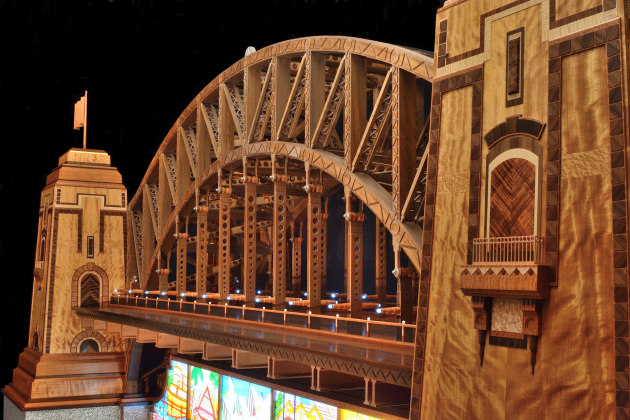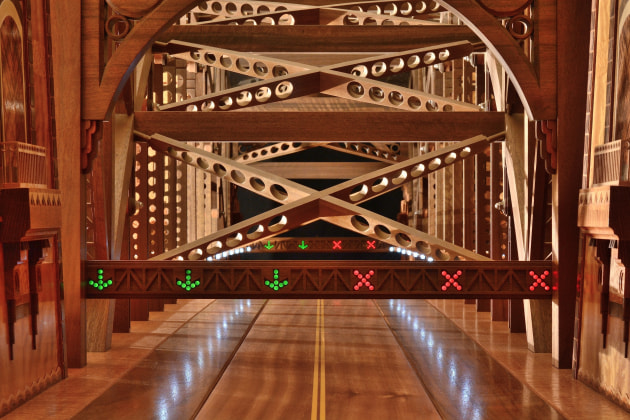Michael Gill: Making the "Sydney Harbour Bridge"
Words: Linda Nathan
Photos: Michael Gill
Michael Gill is not a minimalist kind of guy – ‘more is more’ might be his mantra. Thirty-six years in the making, his Sydney Harbour Cocktail Cabinet was built to make a statement, and at five metres in length, it is, as he says, ‘enormous’. ‘If you’re going to do something well, you may as well overdo it!’, he said.
An enduring labour of love, Michael’s ‘life’s masterpiece’ is intricately constructed, ornate, and a monument to Art Deco inspiration and his love of Sydney.
Why the Sydney Harbour Bridge?
The idea for making it was born decades ago when he and eight other woodworkers got together and formed the Woodworkers Group of NSW. The self-dubbed ‘junta’ all sported beards (‘we were very period people’), and met regularly to plan exhibitions and ‘bore each other with woodworking stories’.
‘One night we were drinking wine and whinging about how hard it was to earn a living as a woodworker in Australia with all the imports coming in. I went home and said to (my partner) Chris, “I’m hearing the only way to make a living with woodwork is to find something people really want that cannot be supplied from overseas, and to make it as interesting as possible. It has to be Australian and there has to be passion behind it”.
‘So I thought – what do I love most in this world that might work? And the Sydney Harbour Bridge just popped into my mind. I thought, that’s it! I’ll make something for people with money. Casinos and international hotels – they always need a bar – it will be a bar in the shape of the bridge. And from that moment on I thought, if I have to whinge about this not selling, then I haven’t tried hard enough.’
The most popular spirits, liqueurs and mixers can reside in the ‘pylons’ that are fitted with dispensers.
There was also an idea that the cabinet might be a back-up ‘superannuation plan’. There had been some years of salaried work teaching art and design at the ANU School of Art (Michael), and working as a botanical illustrator for Sydney Botanic Gardens and CSIRO (Chris), but most of the couple’s working life has been spent privately teaching woodwork, woodcarving and art.
With harbour views Scale-wise the cabinet is higher and somewhat condensed compared to the real thing, Michael explains. It’s made with a panoply of skills. There is fine joinery galore, fretwork, marquetry, extensive mosaics of glass, and inlays of paua shell and mother-of-pearl.

For the fretwork background, three thick sheets of 1930s Qld walnut veneer were laminated. ‘This wood is diabolically loaded with silica and ate through dozens of my finest, German blades, as you can see on the right.’
However, the cabinet is not just an artwork – it’s designed to be used on a commercial scale. ‘I’ve made it an island bar so bar staff can work from all four sides’, said Michael. ‘It needs to work hard for its living, not just sit there looking cute.’
There are ‘pylons’ at each end, as well as drawers and benchtops that can store bottles and literally hundreds of glasses. Under the ‘east and west sides’ a series of panels depict scenes from the harbour foreshore, while below ‘sea level’ there are maritime views of fish and sea creatures.

The mother-of-pearl in the fireworks came from a recycled picture frame. The woods are red cedar, firewheel tree, plane tree and rock maple.
Much of the timber used was milled around the time the Sydney Harbour Bridge was opened (1936). ‘That was a miracle to be honest’, said Michael. ‘All the solid silky oak came from a coffin maker who had huge stores of timber cut in the 20s and 30s...and then of course coffins ceased to be made out of solid timber. I was lucky enough to strike this fabulous collection of silky oak and Queensland walnut. The veneers came from Col Raymond and were cut by his father in the 20s and 30s.’

Over the years
As the years passed, the design evolved. ‘It changed, it improved, it became more complex, it became a little bit cuter and sexier’, said Michael. ‘Every time I thought of something stupid and ridiculously over-the-top and show-off, I’d stick it in! The creature that was on the drawing board in 1987 was a very, very ordinary simple thing, nothing like the thing I finished a couple of weeks ago.’
In the beginning...Michael 'on the brigdge' in 1988
Above all however, it was the spirit of the age the bridge was constructed in that inspired. ‘I think the Art Deco period may have achieved even greater things, had not World War II come along and smashed it to pieces’, Michael lamented. ‘Maybe I’m just taking those decorative techniques and materials a couple of steps further; that sounds a bit arrogant, but it’s what I’ve tried to do.’
Sometimes a year would go by without working on the cabinet, ‘because we had to survive, and because it’s impossible to build something so insane’, Michael confessed. ‘In the beginning I kept tabs on the number of hours I was putting into it (in fact I kept receipts for all the things I bought for tax purposes!), but I gave that up a long, long time ago...’
As Michael and Chris moved around, the cabinet went along too. ‘We’ve had 11 different workshops, all rented. We moved the damn thing five times when we were younger and stronger – and it’s a terribly heavy thing to move.’
Living in regional NSW, the bushfire ‘season’ has been an annual concern. During the 2019–2020 Black Summer bushfires the cabinet had to be evacuated and stored elsewhere. ‘The fire subsequently came to within 400 metres of our gate...’, Michael said.


‘My MG roars out of the north-eastern pylon. The radiator grill is black bean and the windscreen is very thin glass with a laminated sycamore frame. The metal parts are sterling silver, headlights and hub-caps are antique mother-of-pearl and the fenders were carved from the wood of a young lightwood tree (Acacia implexa) which was blown over in front of our workshop years ago.’ Other woods used include coastal banksia, red cedar, Huon pine, firewheel tree, walnut and purpleheart.’
The back story...
So where did Michael’s mad skills come from? Surely he was trained by the woodworking gods and legends? ‘I failed woodworking at school – I hated woodwork’, said Michael, exploding that theory. ‘The teacher only had three fingers on one hand (I think he argued with a bandsaw), and it frightened the hell out of me. I thought, oh no, a woodworking teacher that’s already maimed himself. So I failed and went and did art.’
‘What (eventually) got me into woodwork was (the fact) my father used to make picture frames in his spare time and I enjoyed watching him cut perfect joints at the corners. And then Chris and I bought a Kombi van (back then you had to do that) and we couldn’t afford a camper, so I had to build one and I thought, I’m sure I can do that. Then my uncle gave me a Readers Digest book of how to make things and I read it from cover-to-cover, and that was the beginning of woodwork for me.
‘When Chris and I got together, one of our major interests was history and antiques. We used to visit National Trust houses and look at the really fine cabinetmaking from the 18 and 19th centuries. And because I’d been trained to draw, I gravitated to inlay and marquetry because you could use drawing and design skills. (Decoration has always been important to me.) I’ve never held to the idea of ‘less is more’ – that really upsets me, the lack of decoration that’s happened since the Second World War.’
Losing a loved one
At time of writing, the SHCC is now officially for sale. After 36 years in a relationship, what happens when the time comes to separate? ‘What will happen when the cabinet goes, and there’s a five-metre long vacuum in your workshop’, I asked? ‘Well, I’m dreading that moment’, Michael admitted. ‘My blood is Hungarian and we tend to be dreadfully emotional people. I thought when I finished it I would go into some sort of a decline and die. But no – I’ve got too much to do! Chris and I are planning to do a lot of travelling.’
It looks like the space reclaimed in Michael’s workshop won’t lay vacant for too long however, as plans for the next campervan are on the drawing board. ‘It’s going to be really special’, he said, hinting at future pleasures to come from the more-is-more philosophy. ‘It’ll probably be of the Art Deco period as well, and when that’s finished, we’ll get on the road. I want it to be really, stupidly lovely. I want it to be completely over the top...and I’m looking forward that.’

Daring to dream
I asked Michael for a tip on gaining the confidence to take on big projects and teach oneself new skills. ‘I think you’ve got to commit. Ask yourself: what gets you in the guts? what makes the blood flow in your veins? what do you respond to? It’s always been art for me. When you can isolate what makes you passionate, you zero in on it and think, am I capable? Am I willing to put up with the 4000 errors, and the failures?
‘Most design and high craftsmanship has a lot to do with poetry, and that’s not about putting words together – it’s seeing the poetry in your materials – in mother-of-pearl, in silver, in coloured glass, in wood, in stone... And you’ve got to work through the failures, keep stretching, and it helps if you’ve got a good partner beside you saying “that’s quite good”.’

Cocktails anyone?
The cocktail connection is totally real, by the way. Four o’clock at the Gill/Payne residence will often see one shaken and maybe stirred – ‘Just one mind you!’ – but often it will be a cocktail that has a special significance Returning from a ‘snake rescue’ (Michael and Chris are passionate about caring for wildlife) may call for an orange ‘copperhead cocktail’ or another from Michael’s a book of recipes. Of course the SHBCC has it’s own very special cocktail...
Finally, at the end of our chat I thought I would check again...just one more time. ‘So you’re not into minimalism, I asked? ‘The Bridge cabinet is the least minimalist object I’ve seen in my entire life’, said Michael. ‘The more I could think of to shove on the damn thing, I did! It never once occurred to me to take it easy.’ As Michael would say, chin chin!
First published in Australian Wood Review issue 119






